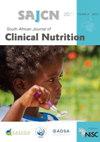测定南非男骑师学徒的体脂百分比(不考虑水合状态)
IF 0.6
Q4 NUTRITION & DIETETICS
引用次数: 0
摘要
目的:确定在脱水和脱水条件下测定BF %的最佳现场技术。设计:采用横断面描述性研究。背景:南非。研究对象:男性骑师学徒17人(平均年龄18.8±1.7岁)。结果测量:使用基于皮褶厚度测量和生物电阻抗分析(BIA)的预测方程确定的%BF结果与参考方法,脱水氘稀释(eDD)的结果一致。结果:eDD平均BF %为9.5±2.8%。Slaughter等人(1988)对8-18岁儿童在两种水合状态下的皮肤褶皱方程,Durnin和Womersley 1使用Siri 2或Brožek等人3对17-19岁儿童在脱水状态下的皮肤褶皱方程,以及Van Loan等人4在脱水状态下的BIA方程是最可接受的方法。结论:无论水合状态如何,建议18岁及以下的骑师学徒使用Slaughter等人的皮褶方程。对于这19年,水化状态必须在测量前确认。如果脱水,建议使用Van Loan等人4 BIA方程,如果脱水Durnin和Womersley 1,建议使用Siri 2或Brožek等人3。本文章由计算机程序翻译,如有差异,请以英文原文为准。
Determining percentage body fat of male South African jockey apprentices irrespective of hydration status
Objective: The aim was to determine the most appropriate field techniques to measure %BF when both euhydrated and dehydrated. Design: A cross-sectional descriptive study was undertaken. Setting: South Africa. Subjects: 17 male apprentice jockeys (mean age 18.8 ± 1.7 years). Outcome measures: Agreement of %BF results determined using predictive equations based on skinfold thickness measurements and bioelectric impedance analysis (BIA) with that of the reference method, euhydrated deuterium dilution (eDD). Results: The mean %BF according to eDD was 9.5 ± 2.8%. The skinfold equations by Slaughter et al. (1988) for ages 8–18 years in either hydration state, Durnin and Womersley 1 using either Siri 2 or Brožek et al. 3 for ages 17–19 years when dehydrated only, and the Van Loan et al. 4 BIA equation when euhydrated only were the most acceptable methods. Conclusion: Regardless of hydration status, the skinfold equation by Slaughter et al. 5 is recommended for jockey apprentices 18 years and younger. For those > 19 years, the hydration state must be confirmed prior to measurement. If euhydrated, the Van Loan et al. 4 BIA equation is recommended and if dehydrated the Durnin and Womersley 1 using either Siri 2 or Brožek et al. 3 is recommended.
求助全文
通过发布文献求助,成功后即可免费获取论文全文。
去求助
来源期刊

South African Journal of Clinical Nutrition
NUTRITION & DIETETICS-
CiteScore
2.50
自引率
9.10%
发文量
21
期刊介绍:
1.The Journal accepts articles from all basic and applied areas of dietetics and human nutrition, including clinical nutrition, community nutrition, food science, food policy, food service management, nutrition policy and public health nutrition. 2.The Journal has a broad interpretation of the field of nutrition and recognizes that there are many factors that determine nutritional status and that need to be the subject of scientific investigation and reported in the Journal. 3.The Journal seeks to serve a broad readership and to provide information that will be useful to the scientific community, the academic community, government and non-government stakeholders in the nutrition field, policy makers and industry.
 求助内容:
求助内容: 应助结果提醒方式:
应助结果提醒方式:


